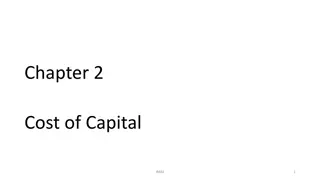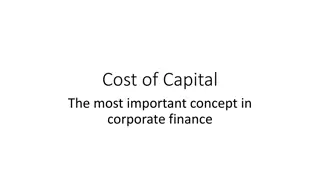Optimal Capital Structure and Value Maximization in Traditional Approach
The traditional approach to finance emphasizes achieving the optimal capital structure by balancing debt and equity to minimize the Weighted Average Cost of Capital (WACC) and maximize the firm's overall value. By understanding the relationship between the cost of debt and equity, financial leverage
3 views • 6 slides
Understanding Risk, Cost of Capital, and Capital Budgeting in Corporate Finance
Explore the concepts of risk, cost of capital, and capital budgeting in corporate finance, including the Capital Asset Pricing Model (CAPM), cost of equity, beta estimation, and cost of capital. Learn how to reduce the cost of capital and understand the impact of reducing the Weighted Average Cost o
0 views • 20 slides
Understanding the Cost of Capital in Finance
The cost of capital is crucial for businesses to determine the average cost of their finance. The Weighted Average Cost of Capital (WACC) is used as a discount rate in financial calculations. It involves estimating the cost of each source of finance and calculating a weighted average. Additionally,
0 views • 14 slides
Estimating the Cost of Capital in Corporate Finance
Explore the process of estimating the cost of capital essential for discounted cash flows models in corporate finance. Learn how to determine the cost of debt, equity capital, and the Weighted Average Cost of Capital (WACC) by combining different sources of financing. Gain insights into capital stru
0 views • 59 slides
Understanding the Significance of Cost of Capital in Corporate Finance
Cost of capital is a fundamental concept in corporate finance introduced by Modigliani and Miller in 1958. It involves calculating the Weighted Average Cost of Capital (WACC) as a combination of debt and equity costs to determine asset value. Despite discrepancies in calculating asset values, WACC r
0 views • 100 slides




